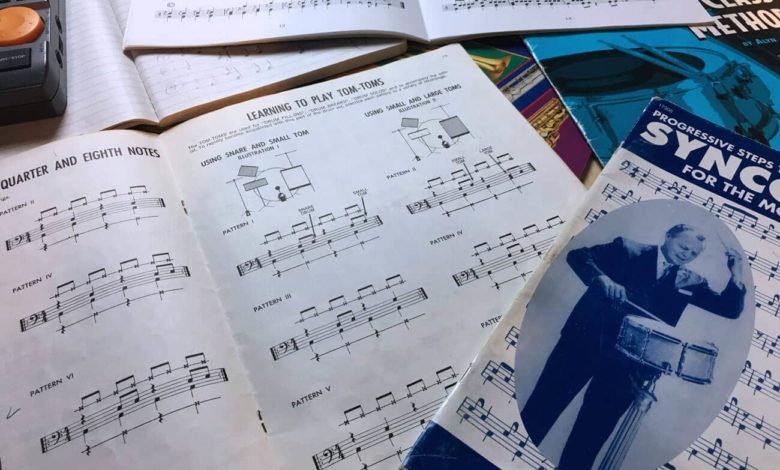
We may earn a commission from the affiliate links on this site. Learn more›
Learning to read and write drum sheet music is not something all drummers will desire or strive to understand.
In fact, I’d go as far to say that most professional drummers either haven’t learned how to read or don’t utilize drum notation on a daily basis.
This is completely okay. There’s no real rule book that states one must learn how to read drum music. Not being able to read music has no effect on your musical ability.
Glenn Holland – Mr. Holland’s Opus
“It’s not about notes on a page. I can teach you notes on a page, I can’t teach you that other stuff. “
That being said, having a decent understanding of musical notation can improve the rate at which you understand drumming concepts and can even set you apart from the crowd (especially if you want to move to Nashville one day to become a session player).
If you can walk into a session, take a look at some notation and immediately play along with the band, you’ll definitely stick out.
Being proficient at reading drum sheet music can help you land the audition, secure a role in a band, get the session gig, or just further your own personal ability to play the kit.

I was fortunate enough to have had the opportunity to take drum lessons when I was younger and I was taught all the basics of reading music.
I studied out of many books including Stick Control, Joe Morello’s Master Studies, Realistic Rock Drum Method, and plenty more. I highly recommend all of these books.
Because I understand the value of reading sheet music as a drummer and how much it has helped me, I want to inspire you and accelerate your learning as you progress as a drummer.
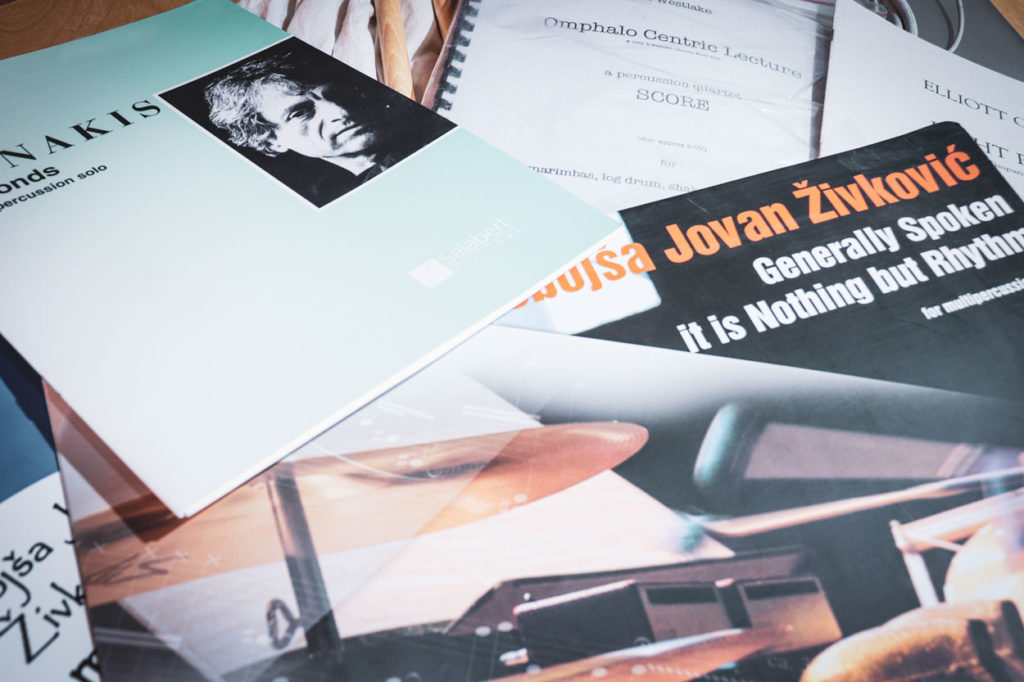
So I know you’re pumped to get started, so let’s dive in. We’ll start off with the absolute basics and make our way up to complicated grooves.
Whether you own just a snare drum, an electronic drum kit, or an acoustic set, you should be reading in no time.
Reading drum sheet music
First off, before we dive deep into drum beats or grooves, it’s important that we nail down the basic structure of a piece of music. First, we begin with the staff.
The staff
In most forms of Western musical notation, the staff serves as a visual representation of the music that is to be played.
With pitched instruments, each space or line corresponds to a musical note. In our case, each space or line corresponds to a different instrument or drum.
The staff is made up of five horizontal lines and four spaces.
Now I’m sure that the staff looks quite confusing, but I’ve done my best to color code it to make it easier for you.
The staff is essentially made up of five different parts:
Clef
Clefs tells the musician how they should interpret the given staff.
For our purposes, we will mostly see the ‘Neutral Clef,’ though there are many others like the treble clef, bass clef, tenor clef, and others.
Bar Line
The bar lines divide the staff into measures.
Measure
Measures are the distance between two bar lines. They help the musician stay on track with the piece and aid in counting passages.
Double Bar
The double bar marks the end of a section of music.
In some cases on certain percussion scores, a single line staff may be used.
If you don’t totally grasp what that means, don’t worry. We’ll be diving in deeper shortly.
The most important, and most understandable part of reading drum sheet music is the drum legend.
The drum legend
No, it’s not a legend written in some sacred textbook from before time, rather, the drum legend tells the performer what drums or instruments to play in a piece.
Now this is just one variation on what a drum legend might be in a given piece of music.
Always check the first page of a method book or solo to see what the legend is before attempting to read it.
In general, drums are signified by regular notes (ie black note head with a stem) while cymbals and other percussion instruments are indicated by an ‘x’ note head.
You won’t need to memorize the legend itself quite yet; you’ll find that it’s relatively easy to distinguish most of the drums apart soon enough.
Let’s now dive into learning when to play a given note and each’s duration.
Time signatures
At first glance, a time signature is much like a fraction.
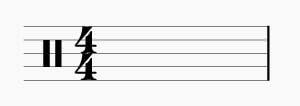
The image to the right is an example of 4/4 time. You can see how much the time signature resembles a fraction
Many people refer to 4/4 as common time, though this is a bit of a misnomer according to mymusictheory.com.

Between the 13th and 17th centuries, people considered triple time music to be ‘perfect’, which is where the C in common time originates.
Though it’s not that way anymore.
By today’s standards, 4/4 and common time are essentially the same. If you see a 4/4 or a C in the staff, treat them the same.
For now, I want you to ignore that bottom number. We will just focus on one number: 4.
That top number (4) tells us how many beats are in a given measure of music.
In 4/4, there are four beats to a measure. Let’s get you up to speed on measures, also known as bars.
Measures
The measures of a piece of music are simply a way to divide it up. Even the most proficient musician would have a very difficult time following along a piece of music that has no breaks or dividers.
It’s like reading a gigantic paragraph block of text on a website. It can be frustrating and easy to get lost.
I do my best to keep my writing simple and straightforward with plenty of breaks.
Measures were not consistently utilized by composers until the mid-17th century. It’s a good thing they were accepted, otherwise reading music would be very difficult today.
Measures are divided up by what is known as a bar line. You can see this in the example below.

Enough about measures and bars, let’s get on to playing with notes and counting.
Understanding basic musical notation
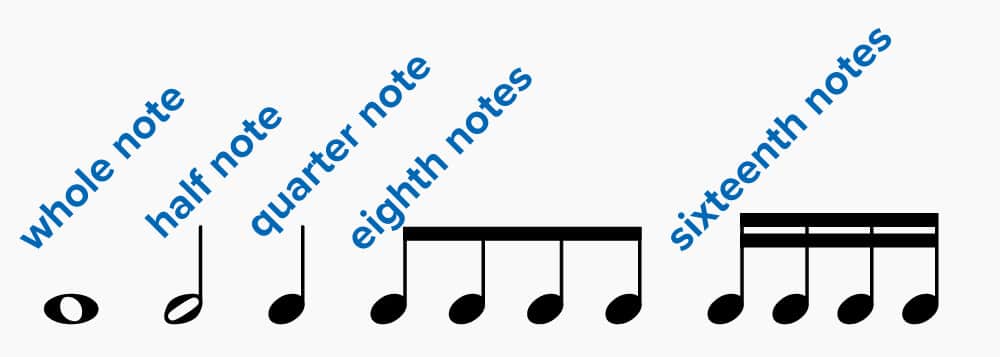
Let’s count a simple bar of 4/4.
Use the audio sample below to hear what this pattern sounds like. The example is four beats on a kick drum in 4/4 time.
Before the kick drum comes in, you’ll hear a 1, 2, 3, 4.

Makes sense how each number corresponds to a bass drum note, right?
The notes you see above are what are known as quarter notes. They are very common and in our case, are the foundation of the 4/4 time signature.
The quarter note is just one of many different types of notes that get different duration values. For my next trick, we take a look at what I like to call The Rhythm Pyramid.
The Rhythm Pyramid
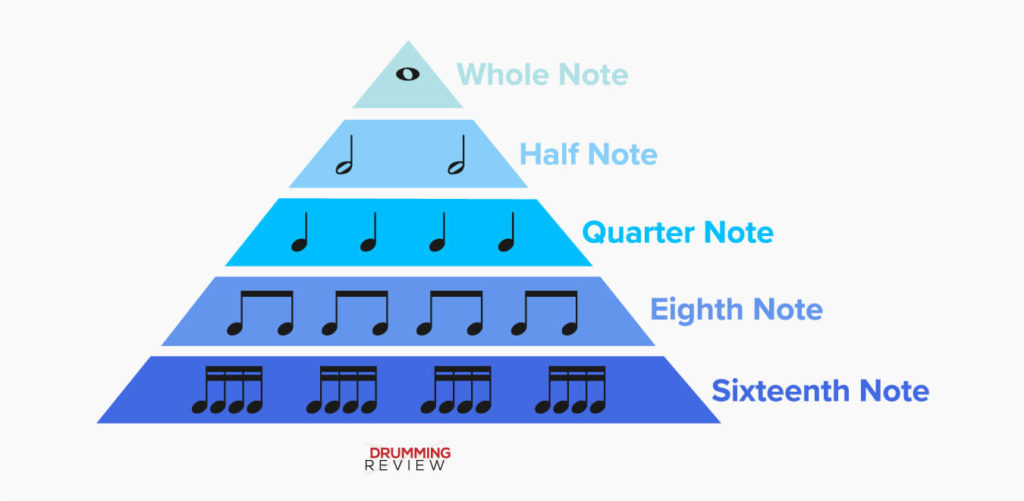
I’ve already mentioned the quarter note briefly in the example above, but this pyramid shows exactly how notes are broken down.
From the top down we have:
- Whole note – this note is represented by a note head with no stem. A whole note consists of a duration equal to the amount of one measure.
- Half note – this note is exactly as it’s name implies, half of a whole note. In 4/4 time, you would only see two half notes for the duration of a measure.
- Quarter note – as referenced in the example above, quarter notes are 1/2 of a half note. In 4/4 time, there are four quarter notes in a bar.
- Eighth note – splitting even further are eighth notes. These notes are half the length of a quarter note. There are eight notes in one bar.
- Sixteenth note – this is getting redundant isn’t it? Sixteen notes, again, are half the length of eighth notes. Sixteen in total in one bar. Math is good. 🙂
This is known as subdivision. It’s a system that all of Western music is reliant on.
Rhythm Pyramid example
If I break down the Rhythm Pyramid into measures, this is what it looks like on paper. You’ll notice we have whole, half, quarter, eighth, and sixteenth notes.

Let’s here the example of the Rhythm Pyramid played by a snare drum.
Were you able to follow along?
You may be wondering what all those numbers and letters are above the notes…
They are used for counting purposes, both visually and audibly.
Numbers are easy to count, but what about the ‘+’ and ‘e’ and ‘a’?
The ‘+’ sign stands for the word “and.”
If you were counting bar #4, you would physically say this:
“One and two and three and four and” in rhythm
Try it out!
Bar #5 is counted like so:
“One e and a two e and a three e and a four e and
I know it may seem ridiculous, but it really works! If you want to master reading drum sheet music, you must master the art of counting!
Alright, we’ve been playing a lot; let’s talk about when we’re not supposed to play.
Rests
In a lot of music, it’s not always about the drums!
Just like how we have the Rhythm Pyramid for notes we play, we also can have the same concept for notes we don’t play, otherwise known as rests.
Let’s hear a quick example of how rests work in the same fashion.

Try your best to follow along with the audio guide. These are simple rests, but as you can see with the ending, rhythms are beginning to get complicated.
Okay, with the boring stuff out of the way, let’s tackle some simple rock grooves!
Basic rock grooves
If you’re getting comfortable reading and understanding drum notation, that’s great!
Right now, however, we’re going to take all that and throw it out the window. Just for a minute.
Experienced drummers who already have a feel on the kit, feel free to skip over this section.
Quick story.
Before my parents decided to buy me a drum set, they had to make sure I was serious.
I was allowed to rent a snare drum and take private lessons.
Every week at lessons I’d wonder when the day would come that I’d get to sit on that magical throne behind my instructor’s kit.
My instructor had a fantastic way of teaching simple grooves and independence.
Instead of using a visual, note-based approach, he allowed me to get hands-on with the drums.
I even found my old lesson plan from so many years ago. Here’s the approach.
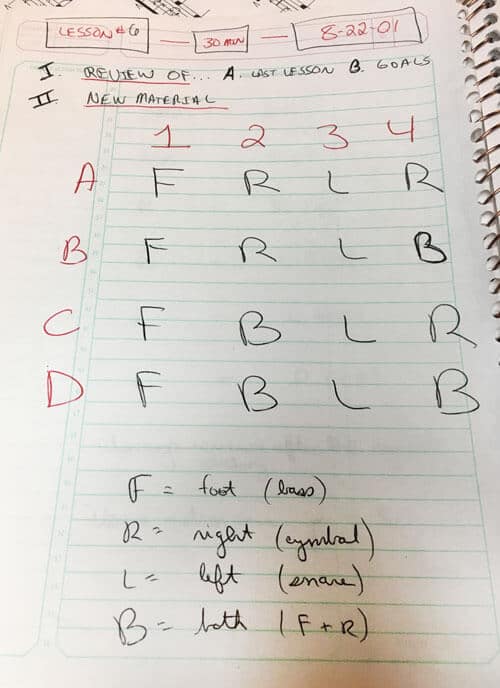
Foot, right, left, right, both
Sounds kind of silly, right? Sit down at your drum set and do exactly that. Use the bass drum, snare drum, and hi-hat only. Play those parts slowly.
Foot. Right. Left. Right.
If you were patient, you should have ended up with something that looks and sounds like this.

In the example, I begin with the groove as written and take it to double time after to demonstrate the full effect of this groove. It’s simple, yet very usable.
As you can see in the notebook examples, there’s also a B, which stands for both. This just implies that you hit your right and and your bass drum on the same beat.
You may be thinking, “dude, that is such a simple groove! I already know how to play this!”
Very true, however, if you ever find yourself in a teaching situation with a young student, you’ll thank me when you’re teaching FRLR grooves and their variations.
Okay, back to reading drum music.
The “Money” Beat
One of the most important drum grooves on the planet happens to also be one of the easiest (to learn, feel will come with time). The “Money” Beat.
If this is your first time playing drums, there’s a good chance you’ll be able to play it.

I almost guarantee you can find a song on the radio right now that uses this groove. Hence the name, Money Beat.
One great way to begin learning grooves like this is to split it up between your hands and feet.
For example, when learning this groove, start with just the hi-hat pattern. Be sure to use a metronome at a slow speed around 60 or 70.
Slowly, begin to add a kick drum hit on the first beat every time through, followed by beat three as well.
Once you feel comfortable with that, try to add the snare on beat two, without losing coordination of your hands and feet. Continue to now add beat four.
If this is too much, another strategy is to just practice the hands until you’re super comfortable and then add the kick in.
Wrapping up
I hope you have gained a better understanding of drum notation and will begin to read more and more drum sheet music.
Now that you have a basic sense drum notation, I suggest you begin learning some basic rock grooves and drum fills!
And if you’re feeling truly ambitious, why not tack a crack at learning the Nashville Number System for drummers? If you ever will aspire to become a session drummer, you’ll need to learn it.
This post is just the beginning and just scratches the surface. If you found any of this helpful, please leave a comment down below.
Feel free to make suggestions, criticisms, you name it. I’m all ears!
Thanks for reading!


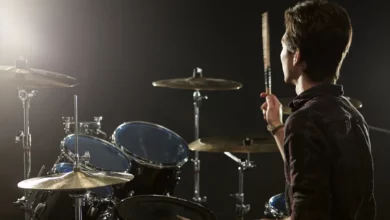

Wow! Thanks so much Nick!! Has helped reignite my passion for percussion. I come from a musical family (father was a drummer and uncle a well known trumpeter-both deceased) and miss our talks about jazz. I used to read music rather well (and was part of organized school and church bands for several years as well) but quit over 35 yrs ago (with only sporadic playing here and there). Now it will be for therapy, self-growth and just plain enjoyment. Thank you young man for this inspiration and a well written and informative article. Thanks again and all the best to you in your future endeavors.
0
Your drum legend shows the high tom and mid tom on the same staff line. That can’t be.
0
Mike, thanks for much for informing me. This is a mistake. I will correct it!
Cheers.
0
Awesome explanation dude
0